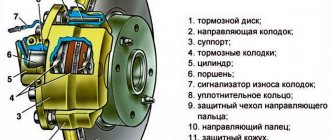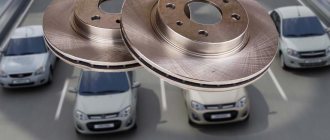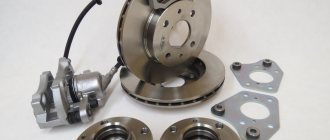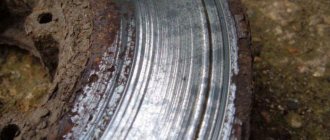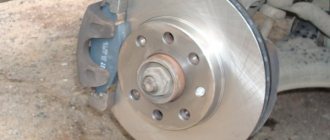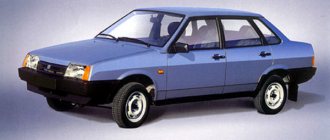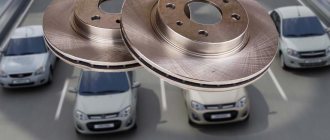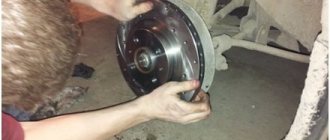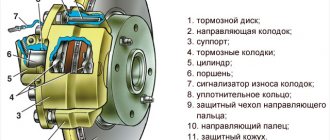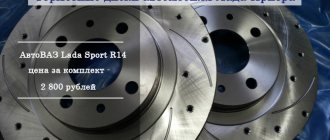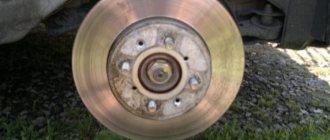Brake discs are designed to get hot. This is the only way to convert the kinetic energy of an accelerating car into thermal energy and then dissipate it in space. But this must happen strictly at the driver’s command. Heating of the brakes in all other cases indicates the presence of a malfunction, as well as emergency options, that is, excessive overheating.
How hot should brake discs get in a car?
Brake discs are designed to get hot. This is the only way to convert the kinetic energy of an accelerating car into thermal energy and then dissipate it in space. But this must happen strictly at the driver’s command. Heating of the brakes in all other cases indicates the presence of a malfunction, as well as emergency options, that is, excessive overheating.
Determining the state of the disk
To find out the exact reason, you need to make sure that the disk was actually operating under high loads. How to do it? You can determine the condition of the working surface visually by color.
You won't need a pyrometer. So, if the surface of the disk is blue, it means the metal was heated to 450 degrees Celsius. It's worse if the shade is black.
In this case, there is every reason to assume that the brakes heated up to 500 degrees Celsius.
[custom_ads_shortcode3]
Features of the car brake system
The purpose of the brakes is to stop the car as quickly and safely as possible. The easiest way to do this is with the help of friction, which occurs in brake mechanisms.
In modern cars, brakes are located on each wheel in order to make the most efficient use of the traction of the tires with the road.
- brake discs or drums, metal parts associated with wheel hubs;
- brake pads, consisting of a base and linings made of a material that has a high coefficient of friction against cast iron or steel and can withstand high temperatures with minimal wear of both the pads themselves and the discs (drums);
- brake drive, mechanical, hydraulic and electronic devices that transmit force from the driver's controls to the brake mechanisms.
There are several types of brake systems; the service and parking brakes play a significant role in heating the discs.
Both of them work approximately the same way - the driver, through the drive, creates a mechanical force on the brake pads, which are pressed against the discs or drums. A friction force arises, directed against the inertia of the car, kinetic energy decreases, and speed drops.
Should brake discs and drums get warm?
If we calculate the braking power, and this is the energy released in the form of heat during braking per unit time, then it will be many times greater than the engine power.
It is quite easy to imagine how the engine heats up, including the energy carried away with the exhaust gases and spent on the useful work of moving the machine with a load.
Such a colossal amount of energy can only be released with a significant increase in temperature. It is known from physics that the energy flux density is proportional to the temperature difference, that is, the difference between the heater and the refrigerator. When the energy does not have time to go into the refrigerator, in this case it is atmospheric air, the temperature rises.
The disk can glow in the dark, that is, gain several hundred degrees. Naturally, it won’t have time to cool down between braking sessions; it will be hot the entire trip.
Causes of overheating
There is a very big difference between heating and overheating. Heating is a normal phenomenon, that is, calculated and tested by the car’s developers, and overheating is an emergency.
Something went wrong, the temperature rose critically. In the case of brakes, this is very dangerous, since overheated parts cannot work normally and very quickly lose strength, geometry and service life.
Consequences of using the handbrake
The simplest thing that almost all novice drivers encounter is forgetting to release the parking brake when starting to drive.
Engineers have been successfully fighting this forgetfulness for a long time. Light and sound alarms have appeared that are triggered when an attempt is made to move when the brake pads are tightened, as well as automatic handbrake controls that are cocked and released by an electric drive when stopping the car and starting off.
But if you still drive with the pads pressed, the significant transmitted power will heat the drums so much that the pad linings will char, the metal will deform, and the hydraulic cylinders will leak.
This is often noticed only when the tires on the rims begin to smoke. Extensive and expensive repairs will be required.
Caliper cylinder piston jammed
In disc mechanisms there are no separate devices for removing pistons from the pads. The pressure in the hydraulic system is removed, the clamping force becomes zero, and the friction force is equal to the product of the pressure on the pad and the friction coefficient. That is, “zero” doesn’t matter what number it is – it will be “zero”.
But it doesn't always work out that way. The block should be retracted by a fraction of a millimeter at least due to the elasticity of the sealing collar. But if corrosion has occurred between the piston and the caliper cylinder, and the piston jams, the pads will remain pressed with non-zero force.
Energy release and uncontrolled heating will begin. It will end only after a certain thickness of the layer has been erased from the lining as a result of overheating and loss of properties. At the same time, the disk will overheat.
Air in the braking system
Rarely, an effect has been noticed when the pads spontaneously press against the discs due to poor air bleeding of the drive.
It expands when heated and begins to press the pads against the discs through the cylinders. But still, much earlier than overheating occurs, the driver will notice that the car practically does not slow down.
Brake disc wear
When worn, the discs lose their ideal geometric shape. A noticeable relief appears on them, the pads try to get used to it.
All this leads to unpredictability of contact between the surfaces of the discs and linings, and any contact will mean overheating with all the ensuing consequences.
Incorrect replacement of brake pads
If the technology for replacing pads is violated, despite its simplicity in the case of a disc brake, the pads may jam in the caliper.
The resulting friction will overheat the disc and caliper guide, which will only worsen the situation. This usually ends with the driver noticing extraneous sounds and a sharp decrease in braking efficiency.
What are the dangers of overheating disks?
The consequences of intense heating of the discs are the formation of a certain film separating the discs and pads. The presence of a film formed as a result of metamorphoses of the properties of the material of the parts worsens the frictional properties of the surfaces of the parts. In other words, the effectiveness of the braking system deteriorates. Moreover, if for some reason you manage to adapt to this style of braking, then you will not be able to avoid boiling of the liquid.
What are the consequences of overheating brake discs?
An extreme increase in the temperature of the brake discs negatively affects the brake pads and calipers, gradually bringing their premature “death” closer.
Important! If replacing the brake pads does not help eliminate overheating, then the reason most likely lies in corrosion that has formed around the rubber of the clutch master cylinder.
How to eliminate heating of disks
There are simple rules for saving brakes from overheating:
- use the brakes only in emergency cases and for a final stop, in all other situations using a coasting motion under positive or negative engine thrust;
- do not use the brakes on long descents in the mountains, only the engine or the mountain brake; the service system is unlikely to survive to the lowest point of the first serious descent; to be convinced of this, it is enough to calculate the potential energy that the car has at the top of the mountain;
- maintain the brake mechanisms in perfect condition, making sure there is no corrosion of the hydraulics and guides each time you replace the pads, using a special lubricant and its application map;
- replace discs with extreme wear in a timely manner, without waiting for them to become completely transparent.
Overheated discs must be replaced. They have lost strength, their coefficient of friction has changed even with new pads, and most importantly, it is uneven over the area, which will lead to jerking and new overheating.
How to prevent overheating
In order to prevent the brakes from overheating, the main contribution is, of course, made by manufacturers, using the most heat-conducting materials for their manufacture and developing ventilated structures in which the brake discs consist of two parts, with a special fan built between them.
The design of the brake disc itself, capable of self-cleaning from dirt and being ventilated by oncoming flow, is considered one of the most successful design discoveries.
In order to prevent overheating of the brakes during operation, it is necessary, first of all, to maintain the brake system in working condition, and for this you need to regularly check:
- brake fluid level in the master cylinder reservoir;
- brake disc thickness;
- brake pad wear.
Why do brake discs get hot?
The process of braking a car is based on the force of friction and cannot but be accompanied by the release of heat. The brakes constantly heat up and cool down. On modern cars, brake discs can be installed not only on the front, but also on the rear axles. Disc brakes are more efficient than drum brakes, easier to maintain and more reliable.
The principle of operation of such a brake is the pressure of the piston (6) on one of the brake pads (4), which begins to rub against the disc. The second block presses on it automatically by the caliper body, which moves along the guides (10). The pads on both sides begin to compress the disk - as a result, the rotation of the wheels slows down.
Of course, heat is generated. The temperature of disc brakes during intensive driving reaches 250-300°C. For sports cars, they are made of ceramics that can withstand heat up to 1000°C without deformation. But they do not go on mass sale due to their high cost.
What is normal temperature?
Alloyed cast iron or steel is used as the material for the manufacture of these elements. There are also ceramic brake discs, however, due to their high cost, they are used only on expensive sports cars.
Although these elements are the least susceptible to overheating. Ceramics does not deform even at temperatures of a thousand degrees Celsius. As for conventional brake discs, which are equipped with 90% of cars, their operating temperature is up to 300 degrees Celsius.
Anything higher entails deformation and increased wear.
[custom_ads_shortcode2]
Why do brake discs get hot?
Heating is not a malfunction if it occurs evenly on both sides and the temperature value does not exceed acceptable limits. In this article, by the word “heat” we mean overheating.
Most discs are made from cast iron. This metal is suitable for daily use - it is inexpensive and has good frictional properties. But it also has disadvantages: due to frequent braking, the cast iron gets very hot, even to the point of smoke. The pads begin to melt and warp.
To reduce heating, or rather, speed up cooling, discs are produced with voids inside (ventilated). This has almost no effect on the characteristics.
To improve performance, perforations and alloys began to be used. If you replace standard brakes with drilled ones, they will cool down faster.
Why do brake discs get hot? The cause is almost always friction. In 99% of cases. And it doesn’t matter whether the front ones are heated or the rear ones, left or right. Having discovered a problem, car enthusiasts usually check the free play of the wheel:
- remove the car from the handbrake or gear;
- jack up the car;
- spin the wheel.
If you hear a rustling sound or the wheel rotates with force, the problem is most likely in the brake caliper, which does not release the pad (or pads) even when the pedal is released.
Often, rust covers the cylinder bore or the outer walls of the brake piston, which prevents it from moving freely. It can also cover the guides. Restoring a caliper at a service station is called development. It is necessary to change the rubber seals - this can only be done if you have a repair kit. Sometimes you have to change the piston too.
Another reason why the wheel rotates slowly and the brakes heat up is wear of the wheel bearing (when the brake disc heats up on one side). Actively heating up, it transfers heat to the disc brakes. True, in this case the movement will be accompanied by a howl or hum at certain speeds.
Well, what if the wheel rotates freely in a suspended state, but after the ride it burns your fingers badly? This can happen for a number of reasons:
- Severe wear or deformation of discs. As their thickness decreases, heating occurs faster.
- Installation of new low-quality pads.
- Replacement of brake fluid with inappropriate one.
- Large production of pads.
- The front brake discs of cars with rear drum brakes get hot - because the front axle bears a large load when braking.
- Excessively aggressive driving. With constant acceleration and sudden stops, the brakes do not have time to cool down.
- Delamination of the inner surface of the brake hose. This is an obstacle to the circulation of brake fluid - the pads will not be able to diverge normally.
- Air in the brake system circuit.
Front brake discs
- wear;
- wedging caliper;
- low quality pads;
- aggressive driving with rear drum brakes;
- The pads were installed incorrectly.
Source
How the malfunction manifests itself
The malfunction, which results in intense heating of the brake disc, manifests itself as a characteristic metallic squeak from friction between metals. As a rule, one brake pad begins to jam, so the brake disc on one side overheats.
Curvature of the front discs, since they are the ones that most often suffer from such a defect, is accompanied, in addition to overheating, by a beating in the steering wheel when driving.
Severe wear of linings and discs (below the minimum permissible values) is manifested in a deterioration in their braking qualities and an increase in the distance required to stop the car. In addition, it may be accompanied by a squeak from the contact of the metal part of the pad with the disc shoulder and a decrease in the level of brake fluid in the master cylinder reservoir.
[custom_ads_shortcode3]
Heavy braking
Wheel rims may become hot and this is considered normal. This happens when the car stops, when friction between the brake pads and discs occurs.
The front wheels can get hot for the following reasons:
- Temperature. In the hot summer, any parking leads to the fact that the wheel rims become very hot under the influence of sunlight, and this fact must be taken into account.
- Braking intensity. For example, while driving in a city or traffic jam, the driver very often presses the brake pedal, and in this case, overheating is also inevitable.
- Movement speed. While on the track, the discs, as well as the rubbing elements of the brake system, are blown by oncoming air, which leads to effective cooling. And in the city, the car usually moves at low speed, so the brakes heat up.
To avoid such overheating, it is necessary to monitor the temperature of the discs after driving in the cool season, at normal speed, and also when stopping without using the brakes. Experts note that in the absence of the scorching sun and frequent braking, a working car will have cold or slightly warm rims.
Front brakes and their heating
Let's put it this way - according to the laws of physics, friction releases a significant amount of thermal energy. With strong friction - a VERY large amount. The fact that the brake discs heat up to the point that it hurts to touch them is absolutely normal. Sometimes, during intense driving and braking (respectively), the heating is so strong that even the disk (wheel) itself becomes hot.
And the fact that there is uneven wear on the pads means that the caliper is just working poorly. It is necessary to clean it and the guides. In short, do maintenance on the calipers.
- City: AUDI 80 1.6PP 1991
- City: St. Petersburg, Grazhdanka
- Car: KIA Sorento 2.5TDI, Honda Shadow 750 ACE
- Guests
- City: A4 1.6 ADP
quotes: Author - Marduk: Yesterday in warm weather (+4 Celsius) I was driving around the city and when starting off, a “gee” sound began to be made somewhere in the area of the front right wheel. I stopped and decided to touch the brake disc. I shouldn't have done it. Now my finger really hurts. In general, the heating of the disk was just crazy!
The discs should naturally heat up, especially if I’m not mistaken, your car should be non-ventilated according to the standard. Such discs obviously take longer to cool down. Much depends on the quality of the pads. It makes sense to measure the thickness of the disk and replace it if the thickness is below the nominal value.
However, as it turned out, the left brake disc had the same temperature. I understand that when braking, the discs heat up, but should they heat up like that?
You should hang the front wheels together or one at a time and check for ease of rotation, preferably with the engine off. Then start the engine and, after several vigorous presses, check again. If the wheels turn easily, then everything is OK!
Factory guarantees applicable to new cars apply only to discs that have no signs of overheating (discoloration, burnt pads, etc.), from which we can conclude that it is necessary to dose the braking forces depending on the capabilities of the system itself.
I started driving with the disks completely cooled down and when driving at a distance of 5 km in the city, the disks again became incredibly hot! Let's just say that during these 5 km I counted approximately 13 zones where it was necessary to use the brakes (traffic lights/intersections/turns). The discs acquired a temperature similar to the temperature of a Tefal frying pan with a red thermospot. In general, I disassembled the caliper and looked at how the brake cylinder works. The basins are nervously smoking in the corner! When you press the brake pedal, the cylinder comes out, and when you release the pedal, it goes back in (but not to the same distance as it came out). This was not observed at all with TAZs. Yes, the guides work great. Now the question is: where to dig?
Or maybe there is no need to dig at all? It is advisable to check the boiling point of the torm. liquid it must be at least 180 degrees. C. If there is no device, change it every 2 years or earlier if the mileage has reached 60 thousand km.
The pistons should really move freely and, when the pressure disappears, move back somewhat due to the elasticity of the cuff (for basins, as you call them, this is also true).
In conclusion, without wanting to offend the cool RR engine, I will say that the brakes on this car leave much to be desired because... The car's configuration reminds us of a clear lack of sport. signs, which fully applies to the brakes.
Let me remind you that to lubricate the caliper guides it is better to use a special lubricant (usually white), for the guides. pads, copper-containing, and when replacing caliper cuffs, which by the way restores poor return of the pads, the cuffs are soaked in a special liquid (not in all cases).
The main reason for the front brake discs getting hot is
Of course, the main reason for disk overheating is friction. The brake system instantly heats up and does not have time to cool down, especially in the city when driving during rush hour. In such cases, you should take this problem seriously and try to make as little sudden starts and emergency braking as possible. You need to brake more smoothly, especially in our time when cars have become much more powerful and heavier.
The weight of the car plays a big role when braking. For a car with a large mass, you need to use wheels with a large diameter, especially for crossovers and SUVs. Driving style also plays an important role. The more aggressively you drive the car, the hotter the brakes become, and this is entirely up to the driver. But these are all human factors that can cause temperature instability even in a working system, and there are also mechanical features.
Another reason for heating the brake disc is heavily worn out discs and pads. This can happen when they were supposed to be changed, but they didn’t do it on time. After all, when the thickness of the metal decreases, when overheated, it is easier to warp.
- The owner installed new low-quality pads.
- After replacement, the brake system was filled with low-quality brake fluid.
- The disk itself has become deformed. This happens when water gets on heated metal.
- The disc also gets hotter during aggressive driving. In which the constant change of acceleration and braking does not allow the brake elements to cool down.
- If the car is equipped with rear drum brakes, then the front brake discs heat up mainly when braking.
What causes overheating?
Initially, I would like to note that the main reason for the heating of brake discs is friction - the main function they perform. As a result of friction between the surface of the disc and pad, the temperature immediately rises, but it takes much longer to cool down.
Remember how many traffic lights you encounter on the way to work and the distance between them. Think for a second, is there enough time between stops for the disk to cool down? Of course not, hence the overheating.
Driving style is a factor that cannot be overlooked. Each driver is unique in his own way and this uniqueness is reflected in his driving style. It follows that more aggressive and extreme driving leads to the fact that the brake discs will almost always be heated to a high temperature.
Another reason is the failure of any elements of the braking system. For the most part, this reason can be placed on a par with driving style, since the driver directly affects the performance of the system (proper care, timely maintenance, and so on).
The main reasons for overheating of brake discs
Let us consider in more detail the reasons for overheating of brake discs associated with malfunctions of the braking system:
- deformation (change in shape) of the brake disc;
- reducing the thickness of the friction part of the brake pads or the working surface of the disc;
- poor quality of parts;
- rear drum brakes. The presence of such a mixed system directs the bulk of the load to the front axle, because the drum brake is not able to fully perform its task.
Jamming of brake system cylinder pistons
When the driver presses the brake while driving, excess pressure is generated in the system due to the fluid, which is responsible for the movement of the pistons in the brake cylinders. This helps press the pads against the discs and the car stops.
The cylinders are operated in difficult conditions, and various contaminants and water appear on them. And because of this, they begin to deteriorate. Typically, the problem means the inability of the piston to return to its original position on its own due to the resulting vacuum. In this case, the brake pads also cannot move completely away from the disc, leading to an increase in friction.
To diagnose this problem, you just need to disassemble the assembly and examine it for various defects. Afterwards it is lubricated and sealed. The last step must be performed more responsibly, using rubber caps. Therefore, please note that if these elements are lost or damaged, the disks will overheat.
Useful tips
The fact that the brake elements are overheating is far from the most pleasant news for the car owner.
After all, to fix the problem, a complete replacement or re-grooving of the part is required (which is also not a cheap pleasure). How to prevent this? You can save disks; to do this, you need to follow a few simple rules:
- Avoid any contact of water with the calipers. Do not drive aggressively in wet or rainy weather.
- Particular attention should be paid to washing. Wait a while for your discs to cool down. If water gets on hot metal, deformation cannot be avoided. In this case, only complete replacement of the disks will save you. Moreover, they are changed in pairs (just like the pads), even if the adjacent one is in good condition.
- Follow the instructions for replacing pads. Don't wait until they wear down to metal. This will cause deformation and increased heating of the disk.
[custom_ads_shortcode1]
How does the braking system work?
The design of the car braking system is a bit like the shoe brake that most bicycles are equipped with. True, there is a slight difference: on a bicycle, when the brakes are applied, the pads come into friction with the rim, and on cars, with the brake disc (or drum). In addition, bicycle brakes are activated via a cable, while on cars they are activated hydraulically. The vehicle stops due to the creation of friction between the brake disc and pad. This process has its consequences, the main one of which is the formation of a large amount of heat that needs to be put somewhere. To remove the generated thermal energy, there is ventilation for the disc brakes, which was developed specifically for this purpose.
Disc brakes have repeatedly proven their effectiveness during numerous experiments, which automatically elevates them to first place among similar analogues. The temperature of the working surfaces is reduced due to air cooling: during operation, constant air circulation occurs in the system.
How does the braking system work?
The list of advantages of disc brakes also includes “autonomous” cleaning. The fast rotation speed of the discs removes all dirt and dust accumulated on the surface of the part. Many experts believe that the modern disc brake system is very popular due to its efficiency, the ability to make some adjustments to the system, reliability and long service life. The last point is very relevant, given the current prices for spare parts.
Tags: ebc greenstuff, ebc usr series
Comments 57
In the city up to 200 degrees, in the mountains with heavy braking up to 400.
I was playing around with a thermal imager. Brake discs from Mazda RX-8 are on the escape. With active pedaling, the outer diameter of up to 180 heats up inside 90, the brake caliper is about 80. Both the front and rear are approximately the same.
By the way, at small decelerations of 0.2-03 g (city mode), the rear brakes work very actively, because the redistribution of mass is insignificant. And since they are not ventilated and are much thinner, they heat up more. It's all simple.
Thank you! This is what confused me the most. Now I know.
How did you measure the temperature?
To the touch. But I'm buying a thermometer on Monday, so I'll measure it scientifically.
Write me a private message later. And so the average temperature is 170-250C. 250-400 with EMS test. At about 400C, fading occurs when you lose your brakes due to burnout of the binders. The most durable is Sunshine Premium. They did not crumble and the loss in braking force at P = const = 130 bar was less than 10%.
The advertisement promises durability up to 600 or 800 degrees. I’ll write a whole post as soon as I break in the brakes.
The problem is that the brake rotor may not be able to cope with such temperatures. The first signs of disk overheating are the steering wheel beating. This is due to deformation in the area of the so-called swan neck of the brake disc. If this happens, you must continue driving and try not to brake. If it stops immediately, the liquid may boil. From experience, I can say that it is possible to warm up the brakes to 600 degrees, but only in race track conditions and in the presence of a powerful engine. It won't work in the city. The brakes will have time to cool down. In laboratory conditions we heat up to 400 degrees, but this takes time. Up to 600 is possible, but the conditions there will be different. We imitate ordinary city cars, but here we have to imitate some kind of Porsche.
There is also the option of driving along serpentine roads in the mountains. I recently had an incident when I was driving downhill for about 10 kilometers. Or maybe more. The descent was about 20 degrees. Trucks and buses are prohibited from driving along that road out of harm's way. I was very afraid that I would overheat my stock brakes and fly down in full accordance with the laws of physics.
on serpentine roads - engine braking) although on automatic - xs)
I have a manual box. At this angle, engine braking is not enough - it still spins up the revs, even if you don’t press the gas pedal.
well, it usually rarely spins more than 3 thousand - it doesn’t seem to be scary)
There it was spinning around 4 thousand. Maybe I just did something wrong, of course.
then switch the gear down) as in the old books for drivers - from the middle of the last century)
No lower than the second 8). Mazda has the first one only for starting from a standstill.
the engine seems to be very easy to spin) on a Lada the engine slows down more) then go for 4 thousand) if you don’t want to be left without brakes)
hot, this is when the wheel rim cannot be touched.
50-80 degrees are cold.
I remember when the F1 mechanic was changing a tire in front of me, after the battle lap, you could see how hot he was. He simply threw the central nut aside, it was so hot.
The discs and pads are simply grinding in, there is a gap of a fraction of a millimeter, everything will settle down soon.
Are there garage workers in England or only official ones :)?
There are private garages, of course. Only the question of professionalism has not been canceled, has it?
I work at a relatively small station and now a lot of people are giving up service from dealers, spitting on warranties and so on. They come to get service from us.
Hot brakes are when you throw a handful of snow on them, and it evaporates before reaching them)) and everything else is cold))
I wish I could get a handful of snow! Everything is relative - I agree.
Yes, we have already run out of it too)) St. Petersburg on January 31 on the street +4))
How much did you get the wheels for and can you give me the part number if it’s not too much trouble?
Front wheels EBCUSR7310 (pair) - £150.36 or 16 thousand rubles at the exchange rate Rear wheels EBCUSR1197 (pair) - £123.95 or 13 thousand rubles at the rate
Plus the pads are still new. Plus installation work. I’ll write in the car’s log once I’ve completed the first 300 km on them - the minimum running-in required by the EBC.
this is normal) when I installed the new yolks and arrived home, I couldn’t touch the disk with my finger) but I drove about 30 km along the highway. After 300 km I honestly applied it and everything fell into place.
I'll keep track with a thermometer! It's interesting!
The Mazda ones, with a similar driving mode, heated up less, as far as I remember. So I was puzzled. I decided to buy a thermometer - then there will be accurate data. By the way, it will be possible to “try on” the wheels on my wife’s car - she has original ones - she presses the brakes less than me.
On average, new pads break in 500-1000 km.
Source
Air in the brakes
If there is air in the brake system, the pistons are damaged and therefore cannot return to their original position. And this in turn leads to heating of metal products located nearby.
Often this problem can be observed in a car that has previously undergone repairs, during which fluid was completely or partially drained or added. When such actions are carried out, drivers should be aware of the mandatory bleeding of the system, due to which air trapped inside is removed. If these actions are carried out incorrectly, the discs may heat up, the brake pedal may fail, and the effectiveness of the entire braking system may decrease.
It is impossible to determine the presence of air, so if the driver has suspicions, he needs to re-pump, based on the recommendations of the car manufacturer. This is usually required when repairs were carried out on your own or in a service station with inexperienced workers.
Sticky block
Overheating of discs is most often caused by stuck pads. This malfunction can occur due to many reasons. This usually happens due to poor quality of parts, uneven wear, incorrect size, dirt, etc.
For such a diagnosis you will need:
- Place the car on a lift and jack.
- Manually turn the wheel. In this case, the handbrake must be removed and the vehicle must be in neutral gear.
- If there is a stuck brake pad, the wheel will not rotate due to inertia. And if there is a rotation of 1.5-2 turns, the reason should be looked for elsewhere.
The discs on the front wheels get hot, the reasons for the disc heating when replacing pads
After modern cars appeared on the market, manufacturers also managed to improve the braking system. Numerous accidents that occur every day force manufacturers to improve the safety of the braking system. To ensure comfort and safety while driving in any climatic conditions, many manufacturers have introduced high-quality disc brakes used on the front axle. But how should you behave when these parts fail and begin to heat up when moving on dry or wet surfaces? Many people are concerned about the question of why new rims on car wheels heat up.
Discs on the front wheels get hot
Disc brakes work by pressing the brake pads against them. They are able to create the necessary friction to stop the rotating disk in time. Manufacturers usually use cast iron to make quality products. This material has the best friction properties. For example, sports cars are equipped with analogues that are made of carbon fiber.
The front wheels heat up. This material allows you to reduce the weight of the mechanism and create the best braking of the car at high speed.
What is the problem
If the disks on the front wheels heat up above 200 degrees, then this indicates the presence of malfunctions that have arisen for several common reasons. This phenomenon is mainly associated with a violation of the integrity of the structure. Sometimes the product becomes deformed when it falls into a deep hole.
Experts are looking at another problem that could lead to this phenomenon, such as not having enough brake fluid. Sometimes car owners buy low-quality or worn pads. Drum brake pads on the rear wheels play an important role. They are the ones who take the maximum load on themselves, unloading the rear axle. The exact reasons for the strong heating of the front wheel rim can be determined after diagnostics are carried out at a service center.
Solution
To eliminate this reason, manufacturers began to produce special discs equipped with voids inside to ventilate the mechanism. This option only helped to better withstand rising temperatures, but it did not save the problem of material destruction. Because of this, the production of special slotted and perforated parts began, for the manufacture of which steel was used. The former had grooves on all sides, while the latter had ventilation holes covering the surface of the disks.
After replacing standard tires, they heat up significantly less, and when braking, you no longer feel the strong friction that was present before. Some craftsmen try to make holes for ventilation in the disks themselves, but such manipulations can simply crack them. It is also important to monitor the condition of the brake fluid. If it starts to boil, it can completely damage the entire system.
Sometimes you can do without replacing disks. In case of deformations, the craftsman grinds down the curved part of the product, bringing it to its original shape. Such procedures are performed at your own peril and risk, because reducing the metal layer can destroy the entire disc.
If you don't react in time
The car should drive smoothly, so any knocking, vibrations and extraneous noise indicate problems with the brake system. This is also evidenced by increased fuel consumption and the inability to quickly gain speed.
If you do not take care of the problem in time, the friction layer may be damaged, and the discs themselves may become coated. This can cause a sliding effect, which significantly impairs the quality of braking. Sometimes the brake may even fail, which is extremely dangerous.
Brake discs are a very important part of the car. They are able to prevent accidents and guarantee safe driving for the driver. Their timely inspection and maintenance will always allow you to have control over the machine.
Most often, problems with brake discs and pads occur among extreme driving enthusiasts. The average motorist will not often have problems with this system. The key to its normal operation is timely service and quality parts from trusted brands.
Hello, dear car enthusiasts! Once again we return to the eternal topic of car safety while driving - the topic of brakes. A common question from novice car enthusiasts is why brake discs get hot.
Overheating of brake discs is a pressing problem in the operation of the braking system, on which your life and health directly depend. After all, a modern car, even a serial one, is a fairly powerful device that develops considerable speed. Accordingly, its timely stopping by braking helps to avoid many dangerous situations on the road.
What is the normal temperature when the brake disc is operating?
For the manufacture of brake discs for mass-produced cars, steel and alloy cast iron are used. We exclude consideration of ceramic brake discs; this product is more likely for cars with specific tasks.
However, it is worth mentioning that ceramic brakes are still the height of technology. Ceramic brake discs heat up to a temperature of 1000C, they are not subject to deformation. Carbon brake discs are located approximately in the same niche.
Misaligned or damaged brake disc
To the reasons described above, you can also add driving with the handbrake and stuck pads. Because of this problem, geometry is lost, and then, even with working pads, the parts have to constantly contact each other, leading to excessive overheating of the harness.
The destruction of the brake disc is considered more serious. A problem occurs when water gets on an overheated part. And this happens very often. For example, when a car runs into a puddle. Here there is a sharp temperature change and the formation of spider cracks on the disk or its deformation.
A simple inspection will help identify the problem. The part cannot be restored; it needs to be replaced.
Wedging the caliper guides
This problem arises against the background of wear of parts, accumulated dirt, corrosion, and various damages. A visual inspection, which any driver can carry out independently, will help determine that this is exactly the problem that heats up the wheels. If the problem is confirmed, in most cases it can be solved by cleaning and flushing the unit. For example, kerosene is suitable for this.
As you can see, there are many reasons why wheel rims heat up. First of all, the brake system is checked, and then the remaining elements. Good luck!
#wheels get hot#Repair#Advice#What to do

